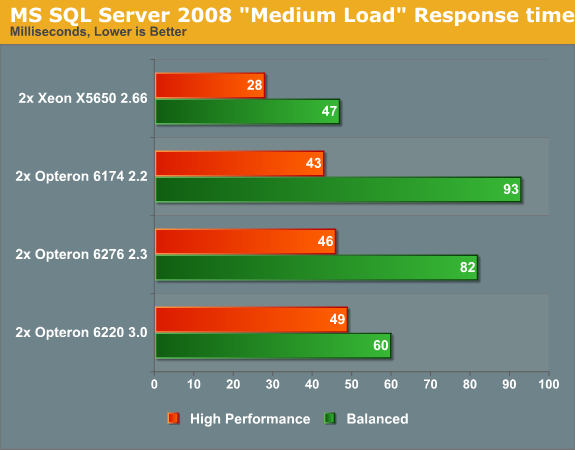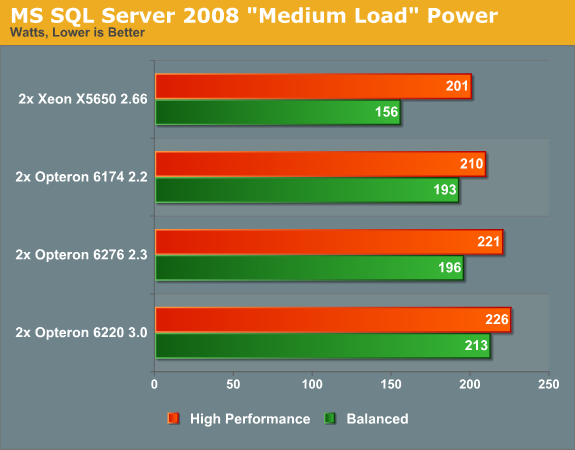The Opteron 6276: a closer look
by Johan De Gelas on February 9, 2012 6:00 AM EST- Posted in
- IT Computing
- CPUs
- Bulldozer
- AMD
- Opteron
- Cloud Computing
- Interlagos
MS SQL Server 2008 R2 at Medium Load
First we test at a moderate load (20-40% load) with 125 concurrent users. Note that these numbers are one set of results from our testing a complete chain of concurrencies (25, 40, 80, 100, 125, 200, 300 ... concurrent users). You will see the complete listing of the results later in the review. For this overview, we focus on a specific concurrency. The database is "warmed up" with a test using 25 concurrent users. We always discard the result at 25 concurrent users as you see some disk I/O peaks at the first concurrency.
We don't look at the throughput numbers here as all servers deliver somewhere between 117 and 122 queries per second as we only demand 125 queries per second. Instead, we focus on response times.

Here the response times are very interesting. From the "full load" numbers, you might conclude that the Opteron 6220 is untenable, as it delivers 30-40% lower throughput while consuming just as much power as the other servers. From those same numbers, we would conclude that the Opteron 6174 is the server platform to get. Switch to a moderate load and our conclusions change.
When testing at medium load, we get a much more accurate and nuanced picture as your servers will probably be spending a lot of time running this kind of load. It seems that if you want to save some power (e.g. run the "Balanced" power profile), the opteron 6220 comes close to the new champion, the Xeon X5650. Since turbo is not enabled in this mode, the 6220 leverages its higher clockspeed to outperform the other Opterons.
Interestingly, the Dynamic Voltage Frequency and Voltage Scaling (DVFS) of the Opteron 6174 performs pretty badly compared to the Xeon and the new Opteron. Enabling DVFS increases the response times by 116% (!) on the older Opteron. The Xeon and Opteron 6276 also get a significant—but lower—hit in response time: +66% and +78% respectively.
The Opteron 6220 suffers much less from this problem, as response times only grow 22%. That clearly indicates that the new Opteron deals much better with DVFS. The reason why the 6276 gets such a high penalty in "Balanced" mode is probably due to the fact that it cannot boost to 2.6GHz or 3.2GHz anymore. A better adapted power policy could definitely improve performance at lower loads. We measured the impact of turbo on the power consumption and it was less than 10%. The energy (power * time) increase was even lower (a few %) as the CPU could put the cores to sleep more quickly.
If you think these kind of response times (<100 ms) don't matter, don't forget that the top 5% queries can easily show 20-50x higher response times. Those are exactly the queries the users might start to complain about.
Let us look at the power figures.

As the Xeon is able to put its cores to sleep more quickly and deeply, the Xeon is a real winner in "Balanced" mode. But notice how the Opteron 6174 performance/watt is no longer attractive: it needs just as much power as Opteron 6276 in balanced mode but delivers worse response times. Meanwhile, the Opteron 6220 fails to impress; it did deliver very decent response times, but it needs 26% more power than the Xeon, which is saving a significant amount of power in "Balanced" mode.










46 Comments
View All Comments
Jaguar36 - Thursday, February 9, 2012 - link
I too would love to see more HPC related benchmarks. Finite Element Analysis (FEA) or Computational Fluid Dynamic (CFD) programs scale very well with increased core count, and are something that is highly CPU dependent. I've found it very difficult to find good performance information for CPUs under this load.I'd be happy to help out developing some benchmark problems if need be.
dcollins - Thursday, February 9, 2012 - link
These would indeed be interesting benchmarks to see. These workloads are very floating point heavy so I imagine that the new Opterons will perform poorly. 16 modules won't matter when they only have 8 FPUs. Of course, I am speculating here.Going forward, these types of workloads should be moving toward GPUs rather than CPUs, but I understand the burden of legacy software.
silverblue - Friday, February 10, 2012 - link
They have 8 FPUs capable of 16x 128-bit or 8x 256-bit instructions per clock. On that level, it shouldn't be at a disadvantage.bnolsen - Sunday, February 12, 2012 - link
GPUs are pretty poor for general purpose HPC. If someone wants to fork out tons of $$$ to hack their problem onto a gpu (or they get lucky and somehow their problem fits a gpu well) that's fine but not really smart considering how short release cycles are, etc.I have access to a quad socket magny cours built mid last year. In december I put together a sandy-e 3930k portable demo system. Needless to say the 3930k had at least 10% more throughput on heavy processing tasks (enabling all intel sse dropped in another 15%). It also handily beat our dual xeon nehalem development system as well. With mixed IO and cpu heavy loads the advantage dropped but was still there.
I'd love to be able to test these new amds just to see but its been much easier telling customers to stick with intel, especially with this new amd cpu.
MySchizoBuddy - Friday, March 9, 2012 - link
"GPUs are pretty poor for general purpose HPC."tell that to the #2, #4 and #5 most powerful supercomputers in the world. I'm sure no one told them.
hooflung - Thursday, February 9, 2012 - link
I think I'd rather see some benchmarks based around Java EE6 and an appropriate container such as Jboss AS 7. I'd also like to see some Java 7 application benchmarks ( server oriented ).I'd also like to see some custom Java benchmarks using Akka library so we can see some Software transactional memory benchmarks. Possibly a node.js benchmark as well to see if these new technologies can scale.
What I've seen here is that the enterprise circa 2006 has a love hate relationship with AMD. I'd also like to see some benchmarks of the Intel vs AMD vs SPARC T4 in both virtualized and non virtualized J2EE environments. But this article does have some really interesting data.
jibberegg - Thursday, February 9, 2012 - link
Thanks for the great and informative article! Minor typo for you..."Using a PDU for accurate power measurements might same pretty insane"
should be
"Using a PDU for accurate power measurements might seem pretty insane"
phoenix_rizzen - Thursday, February 9, 2012 - link
MySQL has to be the absolute worst possible choice for testing multi-core CPUs (as evidenced in this review). It just doesn't scale beyond 4-8 cores, depending on CPU choice and MySQL version.A much better choice for "alternative SQL database" would be PostgreSQL. That at least scales to 32 cores (possibly more, but I've never seen a benchmark beyond 32). Not to mention it's a much better RDBMS than MySQL.
MySQL really is only a toy. The fact that many large websites run on top of MySQL doesn't change that fact.
PixyMisa - Friday, February 10, 2012 - link
This is a very good point. While it can be done, it's very fiddly to get MySQL to scale to many CPUs, much simpler to just shard the database and run multiple instances of MySQL. (And replication is single-threaded anyway, so if you manage to get one MySQL instance running with very high inserts/updates, you'll find replication can't keep up.)Same goes for MongoDB and, of course, Redis, which is single-threaded.
We have ten large Opteron servers running CentOS 6, five 32-core and five 48-core, and all our applications are sharded and virtualised at a point where the individual nodes still have room to scale. Since our applications are too large to run un-sharded anyway, and the e7 Xeons cost an absolute fortune, the Opteron was the way to go.
The only back-end software we've found that scales smoothly to large numbers of CPUs is written in Erlang - RabbitMQ, CouchDB, and Riak. We love RabbitMQ and use it everywhere; unfortunately, while CouchDB and Riak scale very nicely, they start out pretty darn slow.
We actually ran a couple of 40-core e7 Xeon systems for a few months, and they had some pretty serious performance problems for certain workloads too - where the same workload worked fine on either a dual X5670 or a quad Opteron. Working out why things don't scale is often more work than just fixing them so that they do; sometimes the only practical thing to do is know what platform works for what workload, and use the right hardware for the task at hand.
Having said all that, the MySQL results are still disappointing.
JohanAnandtech - Friday, February 10, 2012 - link
"It just doesn't scale beyond 4-8 cores, depending on CPU choice and MySQL version."You missed something: it does scale beyond 12 Xeon cores, and I estimate that scaling won't be bad until you go beyond 24 cores. I don't see why the current implementation of MySQL should be called a toy.
PostgreSQL: interesting several readers have told me this too. I hope it is true, because last time we test PostgreSQL was worse than the current MySQL.